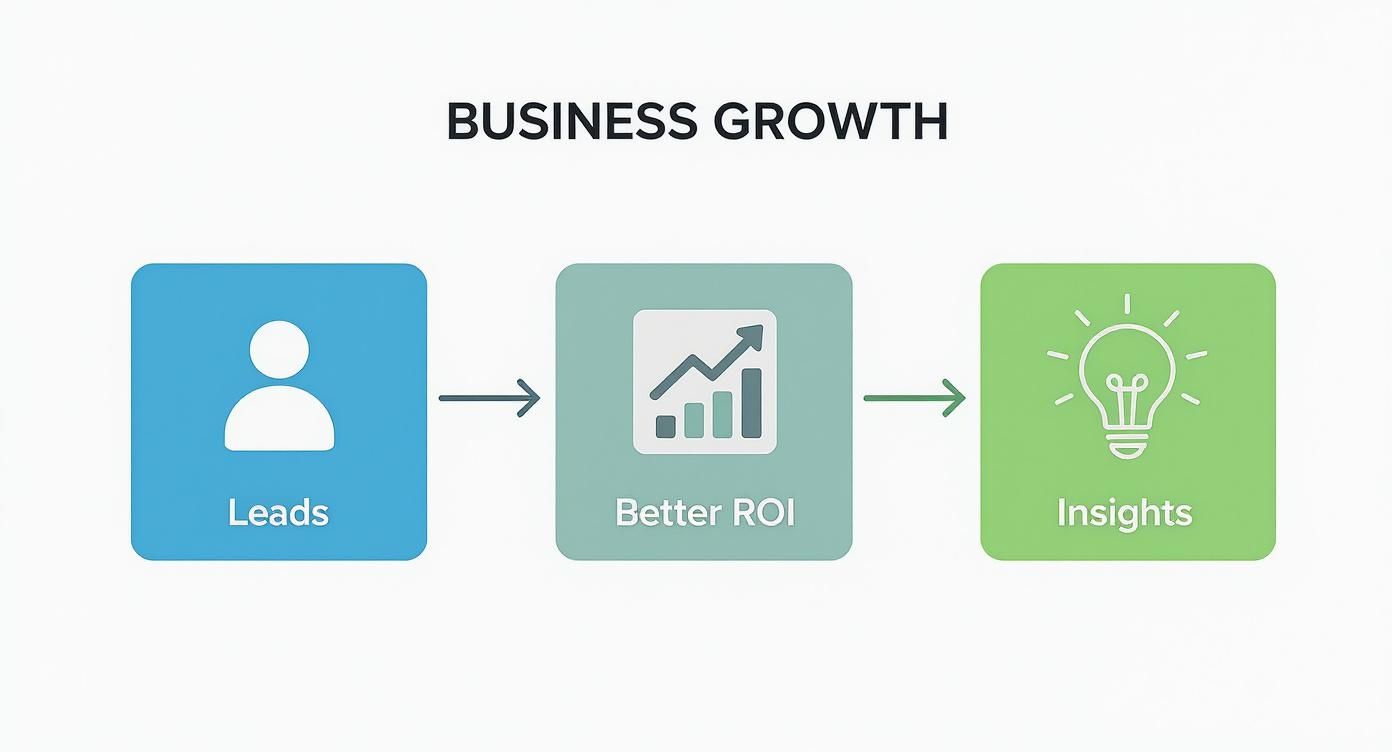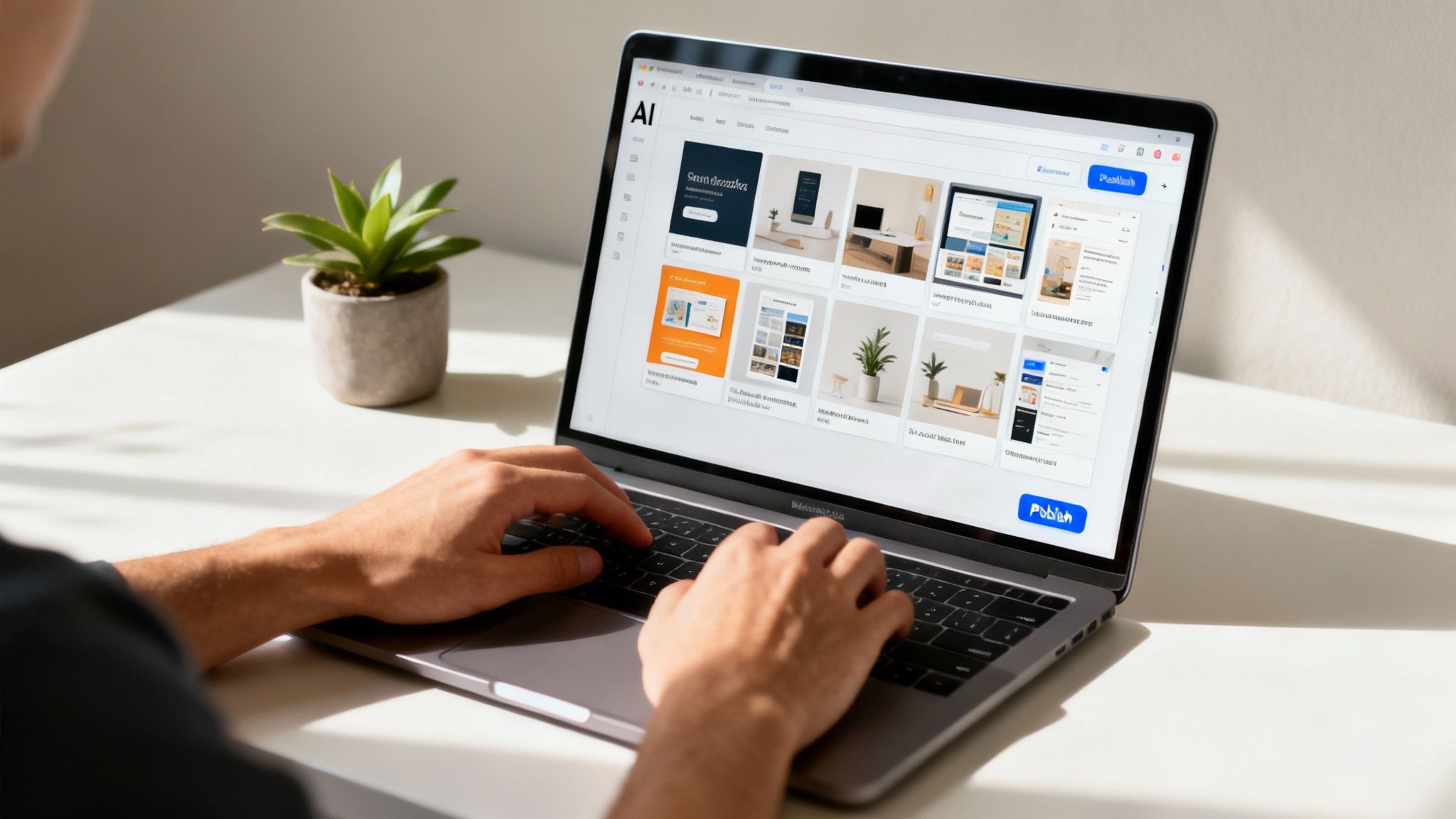What Is a Landing Page Explained: A Simple Guide
This article was assisted with AI. We may include links to partners.
So, what exactly is a landing page?
Think of it as a single web page built for one specific marketing campaign. It’s the first page a person lands on after clicking a link in an ad, an email, or a social media post. Unlike your homepage, which is like a busy lobby with doors leading everywhere, a great landing page has only one door and one destination.
Landing Pages in Simple Terms
Imagine you're scrolling through Instagram and see an ad for the perfect pair of running shoes. You click it.
What do you expect to see next? A page all about those specific shoes, right? You don't want to be dumped on the company's homepage and forced to hunt through a dozen menus to find what you were looking for.
That direct, focused page dedicated to just the running shoes? That's a landing page.
It removes all the usual distractions—like the main navigation bar, sidebars, or links to other products—to guide you toward a single, clear action. This focus is what makes it such a powerful tool.
The Real Purpose of a Landing Page
At its core, a landing page is all about conversion. A "conversion" is just getting a visitor to do the one thing you want them to do. This one desired action is called the Call-to-Action (CTA), and it's the entire reason the page exists.
What kind of action are we talking about? It could be anything that moves a potential customer along their journey.
Common goals usually fall into a few buckets:
- Capturing Leads: Getting someone to fill out a form in exchange for something valuable, like an ebook, a checklist, or a webinar spot.
- Driving Sales: Convincing a visitor to buy a specific product right then and there.
- Scheduling a Demo: Encouraging a potential client to book a call or see a product demonstration.
Actionable Tip: Don't send paid ad traffic to your homepage. It's one of the most common—and costly—mistakes businesses make. Always create a dedicated landing page that matches your ad's message to get the best return on your investment.
By creating a clear, direct path with no detours, you drastically increase the odds of a visitor taking that one important step. This laser-focused approach is what separates a landing page from every other page on your site, making it absolutely essential for getting a real return on your marketing dollars.
Building these kinds of focused pages is easier than you think. Tools like the Solo AI Website Creator are designed to help you get these high-converting pages up and running in no time.

Landing Page vs Homepage At a Glance
It's easy to get them mixed up, but a landing page and a homepage serve very different functions. Think of your homepage as the front door to your entire business and a landing page as a private entrance for a specific event.
Here's a quick breakdown of the key differences:
| Feature | Landing Page | Homepage |
|---|---|---|
| Primary Goal | Single, focused conversion (e.g., sign up, buy now) | General exploration and navigation |
| Traffic Source | Specific marketing campaigns (ads, emails) | Diverse sources (direct, search, referrals) |
| Number of Links | Minimal, usually just one CTA link | Many links (navigation, footer, internal content) |
| Target Audience | A specific segment for a single offer | Broad, general audience |
| Content Focus | Deep dive into one specific product or offer | Overview of the entire brand and its services |
In short, your homepage is designed to welcome everyone and show them around, while a landing page is built to persuade a specific visitor to take one specific action. Both are critical, but they have completely different jobs to do.
Why Landing Pages Are a Game-Changer for Growth
Think of a landing page as your company's best salesperson. It’s always on, laser-focused, and incredibly persuasive. It works around the clock, turning clicks from your marketing campaigns into real, tangible leads and customers.
The secret to its power is its singular focus. Unlike a busy homepage with dozens of links and distractions, a landing page has one job and one job only: to guide a visitor toward a specific action. This clarity is what dramatically increases the odds they’ll actually convert.
This direct approach is a perfect match for paid advertising. When you’re spending money on a Google or Facebook ad, the last thing you want is to waste that click by sending someone to a generic page. A dedicated landing page ensures your investment pays off by creating a seamless journey where the page’s message perfectly mirrors the ad’s promise.
Measure What Matters
One of the most powerful aspects of using landing pages is the crystal-clear data they provide. Since each page is tied to a specific campaign, you can finally measure your return on investment (ROI) with precision. You’ll know exactly which ads, offers, and messaging truly connect with your audience.
This lets you stop guessing and start making marketing decisions based on hard evidence. You can easily track the metrics that move the needle:
- Conversion Rate: The percentage of visitors who take the action you want.
- Cost Per Lead: Exactly how much you’re spending to get each new contact.
- Visitor Behavior: How people interact with your page, showing you what’s working and what isn’t.
Actionable Tip: Don't just track conversions; analyze the data. If a page has high traffic but a low conversion rate, try changing the headline or call-to-action button. Small tests can lead to big improvements in your campaign performance.
From Clicks to Customers
At the end of the day, landing pages are growth engines. They are fundamental to boosting lead generation because they offer a simple, low-friction path for potential customers to raise their hand and show interest.
This is especially true when you pair them with smart lead generation social media strategies, turning passive followers into active leads.
This focused strategy has a direct impact on your bottom line. By consistently capturing leads and giving you clear performance data, landing pages become a cornerstone of sustainable business growth. To take your efforts to the next level, check out our guide on how to improve your website conversion rates and turn more of those visitors into loyal customers.
Anatomy of a High-Converting Landing Page
A landing page that actually converts isn't magic; it's a carefully assembled machine where every single part has a job to do. When all the pieces work together, they create a seamless experience that guides your visitor right where you want them to go.
Think of it like a recipe. Each individual ingredient is simple, but when you combine them correctly, you create something delicious. An effective landing page is the same—it turns a handful of simple elements into a compelling argument.
The Five Essential Building Blocks
Every successful landing page, no matter the industry or the offer, is built on a shared foundation. If you can master these five key components, you’re already on your way to creating pages that deliver real results.
These are the non-negotiables you absolutely have to get right:
- A Magnetic Headline and Subheading: Your headline is your first—and sometimes only—impression. It must grab attention immediately and clearly state the value of your offer in one punchy sentence.
- Persuasive and Scannable Copy: This is where you explain the promise made in your headline. Use short paragraphs, bullet points, and bold text to make it ridiculously easy for people to scan and absorb the key benefits.
- Compelling Visuals: A great image or video can get your message across faster than a wall of text. Your visuals need to be high-quality, directly related to your offer, and support the copy instead of distracting from it.
- Trust-Building Social Proof: People trust other people more than they trust brands. Including testimonials, customer logos, or case studies adds a layer of validation that makes your offer more believable and crushes any hesitation.
- An Irresistible Call-to-Action (CTA): This is the most critical part of the page. Your CTA needs to be a clear, concise, action-oriented button that tells the visitor exactly what to do next.
This infographic breaks down how these elements come together to drive growth by turning visitors into leads, boosting ROI, and giving you valuable customer insights.

Each of these components works together to create a focused user journey, making sure every click has the potential to become a win for your business.
Putting It All Together for Maximum Impact
While each element is crucial on its own, their real power is unlocked when they work together. Your headline grabs attention, your copy builds interest, your visuals forge an emotional connection, and your social proof establishes trust. The CTA is the final piece, giving all that built-up momentum a clear destination. If you want a masterclass in this, check out our guide on what a call-to-action is and how to craft one.
Actionable Tip: Create a smooth, logical flow on your page. The headline should make a promise, the copy and visuals should support that promise, and the CTA should be the natural next step. This makes it not just easy but logical for them to say "yes."
Visuals play a massive role here. Studies have found that people remember 80% of what they see but only 20% of what they read. And get this—the human brain processes images in just 13 milliseconds. To really squeeze every drop of value out of your pages, you should dive into some proven conversion rate optimization tips that can take your results to the next level.
Choosing the Right Type of Landing Page
Not all landing pages are created equal. You wouldn't use a hammer to drive a screw, and the same logic applies here—you need the right tool for the job. Picking the correct type of page for your specific campaign is the first crucial step toward getting the results you want.
Generally, landing pages fall into two main categories, each with a very different purpose. Understanding this difference is key to creating a focused experience for your visitors.
Lead Generation Pages
A lead generation landing page, often called a "lead gen" page, has one simple mission: to capture a visitor's information. The main feature is a web form where people can enter their name, email, or other details in exchange for something valuable you're offering.
Think of it as a straightforward trade.
- You offer: a free ebook, a webinar seat, a helpful checklist, or a free consultation.
- They give you: their contact info, which is permission to start a conversation.
This page is your best friend when you’re looking to build an email list or start nurturing potential customers at the beginning of their journey with you.
Click-Through Pages
On the other hand, a click-through landing page is built to do something else entirely. Instead of a form, its main job is to get someone to click a button—a big, obvious call-to-action (CTA) that sends them to the next step, like a checkout or a detailed sign-up page.
The goal here is to "warm up" the visitor. You give them just enough compelling information—product benefits, cool features, maybe a great photo—to build their confidence and get them excited to move forward. It’s a common sight in e-commerce, where a page might highlight a single product before sending you off to the cart to seal the deal.
Landing pages have been a cornerstone of digital marketing since the early 2000s for a reason—they work. The average landing page conversion rate hovers around 6.6%, but that number can swing wildly. In the B2B world, for example, the median hits a much stronger 13.3%. To see how your own industry stacks up, you can dig into more landing page statistics at Hostinger.com.
How to Create Your First Landing Page

If you think building your first landing page is going to be a technical nightmare, I have some good news. Gone are the days of needing to hire a developer or struggle with complex software. The whole process is much easier than you'd expect.
The secret is using a tool that does the heavy lifting for you. A platform like the Solo AI Website Creator is designed to cut out the complexity, offering simple, intuitive features that walk you through every step. You get to focus on your message and your offer, not the technology.
This approach means you can get your page live in no time, and it will be built to convert right from the start.
Simple Steps to a Live Page
Ready to get started? Launching your page really boils down to just a few straightforward steps. You don’t need a background in design or marketing to build something that looks professional and actually works.
Here’s a simple plan to follow:
- Pick a Professional Template: Start with a pre-built layout that already fits your goal. Whether you're launching an ebook or a webinar, a great template gives you a huge head start.
- Customize Your Content: This is where you bring your offer to life. Swap out the placeholder text with your powerful headline and benefit-focused copy. Drop in your own images to make it truly yours.
- Add Your Call-to-Action (CTA): Place your sign-up form or button. This is the most important part of the page, so make sure it stands out and tells people exactly what to do next.
- Publish with a Single Click: Once you’re happy with how everything looks, you can push it live to the web instantly. It’s that simple.
Actionable Tip: Don't consider your landing page "done" after you publish. Use the data you collect to make small improvements over time. Testing one change at a time, like the button color or headline text, is the best way to increase your conversions.
This practical approach lets you launch your campaign and start seeing results fast. If you want to dive deeper into the strategy, check out our guide on how to create high-converting landing pages that boost sales.
Frequently Asked Questions
Even after you've got the basics down, a few questions about landing pages always seem to pop up. Nailing these details is what separates a page that just exists from one that actually gets results.
Let's clear the air on a few of the most common points of confusion so you can get back to building with confidence.
Can I Just Use My Homepage as a Landing Page?
You could, but it's like using a screwdriver to hammer a nail—the wrong tool for the job. Your homepage is built for a completely different purpose: broad exploration. It's packed with navigation links, different sections, and general info about your entire brand. All of those things are distractions that pull visitors away from the one specific action you want them to take.
A dedicated landing page is so effective precisely because it removes all those distractions. By creating a single, focused path for your visitor, you dramatically increase the chances they'll follow through. That's why dedicated pages consistently outperform homepages for specific campaigns.
Actionable Tip: To keep your visitor focused, remove the main navigation menu from your landing page. This simple change can significantly boost your conversion rate by eliminating escape routes and keeping attention on your call-to-action.
How Many Landing Pages Should I Have?
There’s no magic number here. The best practice is to create a unique landing page for each distinct campaign or audience segment. Why? Because the more tailored the page is to the ad they just clicked and the specific audience you're targeting, the higher your conversion rates will climb.
Think about it: a Google Ad targeting beginners with the term "easy website creator" should lead to a very different page than an ad targeting experienced designers, even if the core product is the same. This personalized approach makes the visitor feel understood and instantly builds their confidence in your offer. It's not at all uncommon for businesses to have dozens, or even hundreds, of active landing pages running simultaneously.
What Is a Good Landing Page Conversion Rate?
This is the million-dollar question, and the honest answer is: it depends. A "good" conversion rate can vary wildly depending on your industry, the value of your offer, and where your traffic is coming from. While some reports put the cross-industry average somewhere around 6.6%, that's just a general benchmark. Some niches might be thrilled with a 3% rate, while certain B2B offers can pull in over 13%.
Instead of getting fixated on a universal number, a much more productive approach is to:
- Establish your own baseline: See how your very first landing page performs. That's your starting point.
- Focus on continuous improvement: Use A/B testing to experiment with different headlines, images, and calls-to-action to steadily nudge your own conversion rate upward over time.
This method of making constant, small improvements is far more valuable than chasing a generic industry average you have no context for.
Ready to build a landing page that actually converts, without the technical headaches? With the Solo AI Website Creator, you can launch a professional, high-performing landing page in minutes. Get started for free and turn your great ideas into powerful marketing tools.
